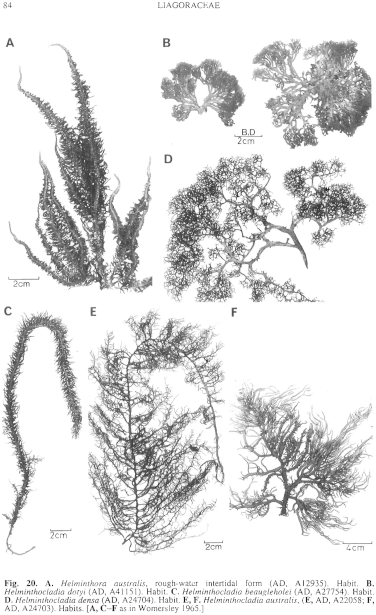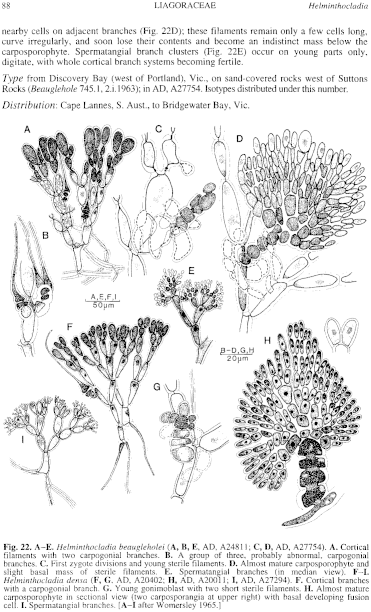|
|
|
|
|
|||||||||||
|
Electronic Flora of South Australia Species Fact Sheet
Phylum Rhodophyta – Class Florideophyceae – Order Nemaliales – Family Liagoraceae
Thallus (gametophyte) (Fig. 20C) red-brown, 10–30 cm high, with one to several axes 2–4 (–6) mm in diameter, densely covered with short, mostly simple laterals 2–10 mm long and 0.5–1 mm in diameter; older ramuli sometimes branched several times; all parts terete except lower compressed axes of older plants. Holdfast discoid, 2–5 mm across; epilithic. Structure with a dense medulla of slender filaments, fairly loosely arranged, and a cortex (Fig. 22A) 160–210 µm broad, consisting of anticlinal filaments of elongate cells, subdichotomously branched every 1–3 cells, with the terminal cells slightly enlarged, ovoid to clavate, (14–) 18–35 (–40) µm long by (6–) 10–15 µm in diameter; rhodoplasts (Fig. 22A) stellate, with a central pyrenoid.
Tetrasporophyte unknown.
Reproduction: Sexual thalli monoecious, usually with abundant carposporophytes. Carpogonial branches (Fig. 22A) 3 (–4)-celled, curved, laterally situated on inner cortical filaments, occasionally developing as a several-celled branch or rarely forming 2–3 carpogonial branches on a supporting cell (Fig. 22B); carpogonium shortly conical. Zygote dividing into 2 or 3 cells by transverse or partly oblique divisions (Fig. 22C), developing the gonimoblast from the upper of these cells, then segmenting obliquely to give an erect, compact mass of branched gonimoblast filaments (Fig. 22D) with ovoid terminal carposporangia (12–) 15–20 [trn long by 4–8 µm in diameter. Cells of carpogonial branches usually developing greatly enlarged pit-connections (Fig. 22D) following fertilization, sometimes losing their identity in a fusion cell; lower cells of gonimoblast not involved in the fusion cell; carpogonial branch cells with dense, homogeneous contents during early gonimoblast development, later becoming empty and indistinct; mature carposporophytes 100–200 µm across in surface view, with carposporangia at or just below the level of outer cortical cells, surrounded by normal cortical filaments only. Sterile post-fertilization filaments develop from the cell(s) above that earing the carpogonial branch, and from nearby cells on adjacent branches (Fig. 22D); these filaments remain only a few cells long, curve irregularly, and soon lose their contents and become an indistinct mass below the carposporophyte. Spermatangial branch clusters (Fig. 22E) occur on young parts only, digitate, with whole cortical branch systems becoming fertile.
Type from Discovery Bay (west of Portland), Vic., on sand-covered rocks west of Suttons Rocks (Beauglehole 745.1, 2.i.1963); in AD, A27754. Isotypes distributed under this number.
Distribution: Cape Lannes, S. Aust., to Bridgewater Bay, Vic.
Taxonomic notes: H. beaugleholei is distinguished from other species of Helminthocladia by its habit, with long axes densely covered with short laterals.
References:
WOMERSLEY, H.B.S. (1965). The Helminthocladiaceae (Rhodophyta) of southern Australia. Aust. J. Bot. 13, 451–487, Plates 1–7.
The Marine Benthic Flora of Southern Australia Part IIIA complete list of references.
Publication:
Womersley, H.B.S. (14 January, 1994)
The Marine Benthic Flora of Southern Australia
Rhodophyta. Part IIIA, Bangiophyceae and Florideophyceae (to Gigartinales)
Reproduced with permission from The Marine Benthic Flora of Southern Australia Part IIIA 1994, by H.B.S. Womersley. Australian Biological Resources Study, Canberra. Copyright Commonwealth of Australia.
Illustrations in Womersley Part IIIA, 1994: FIGS 20C, 22 A–E.

Figure 20 enlarge
Fig. 20. A. Helminthora australis, rough-water intertidal form (AD, Al2935). Habit. B. Helminthocladia dotyi (AD, A41151). Habit. C. Helminthocladia beaugleholei (AD, A27754). Habit. D. Helminthocladia densa (AD, A24704). Habit. E, F. Helminthocladia australis, (E, AD, A22058; F, AD, A24703). Habits. [A, C–F as in Womersley 1965.]

Figure 22 enlarge
Fig. 22. A–E. Helminthocladia beaugleholei (A, B, E, AD, A24811; C, D, AD, A27754). A. Cortical filaments with two carpogonial branches. B. A group of three, probably abnormal, carpogonial branches. C. First zygote divisions and young sterile filaments. D. Almost mature carposporophyte and slight basal mass of sterile filaments. E. Spermatangial branches (in median view). F–I. Helminthocladia densa (F, G, AD, A20402; H, AD, A20011; I, AD, A27294). F. Cortical branches with a carpogonial branch. G. Young gonimoblast with two short sterile filaments. H. Almost mature carposporophyte in sectional view (two carposporangia at upper right) with basal developing fusion cell. I. Spermatangial branches. [A–I after Womersley 1965.]

|
Email Contact: State Herbarium of South Australia |

|